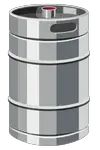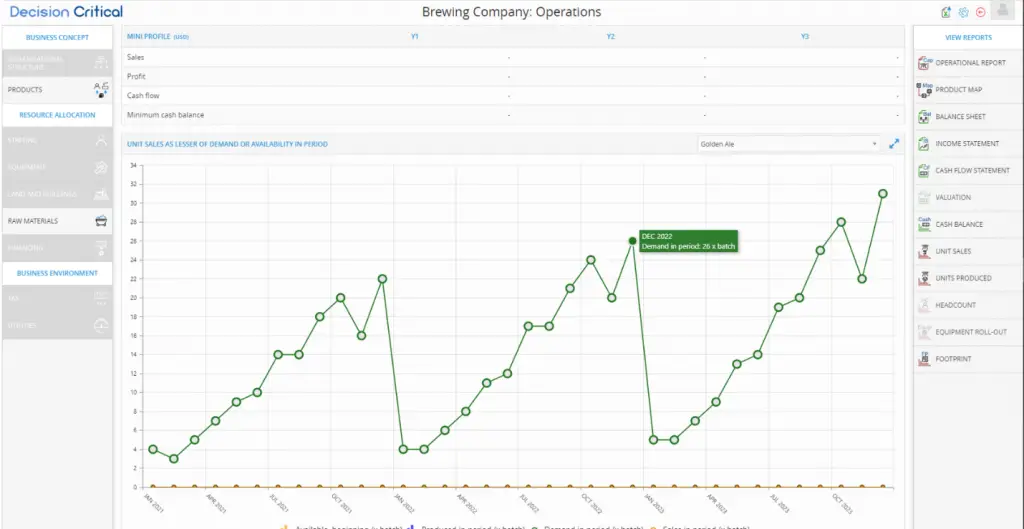Allow me to make the understatement of the era. Covid-19 has been a difficult time for breweries. Business has changed, meta morphed and regretfully many closed. Others hang on, albeit by the skin of their teeth. This is addressed to you, those who know not what tomorrow may bring. There is a way to the future. I will share my hard-earned truths.
Raising money short-term is a challenge but not insurmountable. One avenue are bridge loans, personal or bank backed. Specialty batches, beer auctions, and take-away growler sales are another. The most important is a sound fiscal reconciling of all operations. And even superseding that is an operations work flow analysis, making sure that no motion nor time unit is wasted in the brewery operations.
On the surface, many of these will take time, 1, 2, 8 weeks. In reality, that is a blink of an eye in business. Not all options are the same for everyone. Should one employ a combination or aspect of all, there will be good results.
Going to the well

As driven by need, go to the well, sell some shares in your company to extant shareholders or interested parties, and keep the ops intact.
Back in the day, I by necessity did this in the leanest of times and it kept us going. One partner disliked it as it dilutes shares. However, 10% of something is better than 30% of nothing.
Talk to your banker
As I’ve shared before, in my article, How Much Does It Cost to Start a Microbrewery, you must have a good relationship with your banker. They will often reorganize your loan with modest fees and give you the capital you need to see through until times are better.
Your banker has a personal interest in seeing you continue operations. Banks do not want to own breweries; they wouldn’t know what to do with them. There is also their personal reputation which they’ll consider.
I hate to say this and would only justify doing it under the most extreme need. If your credit is still good, find a 1.9% credit card, if they still exist and pay-off your vendors and fulfill immediate needs with it. Understand the moment you miss a payment, the interest rate goes up to 12.9-22.9% which is what they bank on. I hate it, but there is simply too much at stake.
I and others I’ve known in the biz had their homes personally staked as collateral to the business. It is the long dark tea time of the soul when we reach this point.
I will say, have hope, look to your relationships, personal and professional to help you through the crisis. People will be there for you.
Specialty batches and promotions
The first thing to do today, if you have a tasting room or pub of any description, sell to go Growlers at a too good to be true price. Say a pint of beer cost you $.92 inclusive and your growlers cost $12. Still a fair price for beer.
However, what if you charged $8.99 and sold 40% more? Look at the numbers.
| Growler price | Sales | Cost per unit | Total cost | Gross profit | Net profit |
| $12.00 | 50/ week | $3.68 | $184 | $600 | $416 |
| Growler price | Sales | Cost per unit | Total cost | Gross profit | Net profit |
| $8.99 (promo) | 50/ week | $3.68 | $184 | $449.50 | $265.50 |
| 60 | $3.68 | $220.80 | $539.40 | $318.60 | |
| 80 | $3.68 | $294.40 | $719.12 | $424.80 | |
| 101 | $3.68 | $371.68 | $907.99 | $536.31 |
The motivation to buy is inexpensive beer. Can you double growler sales overnight? If you sell 10 a day you have not much to lose. More volume, better consumer value, more profit.
This $120.31 per week is modest. In a year, it amounts to $6,256.12. This could pay your electricity for the year.
Fiscal and organizational assessment
Tighten up your books. Run a fiscal analysis model so exact that you know the cost of beer production, per unit, per package, per size to the penny on any given day, literally.
This includes but is not limited to:
- Malt/ hop prices
- Domestic shipping
- Import shipping
- Packaging costs – metal/ glass/ paper
- Energy costs
- Debt costs
- Labor costs
Here is a sample summary of annual expenses.
I will use year 2 as a benchmark for expenses.
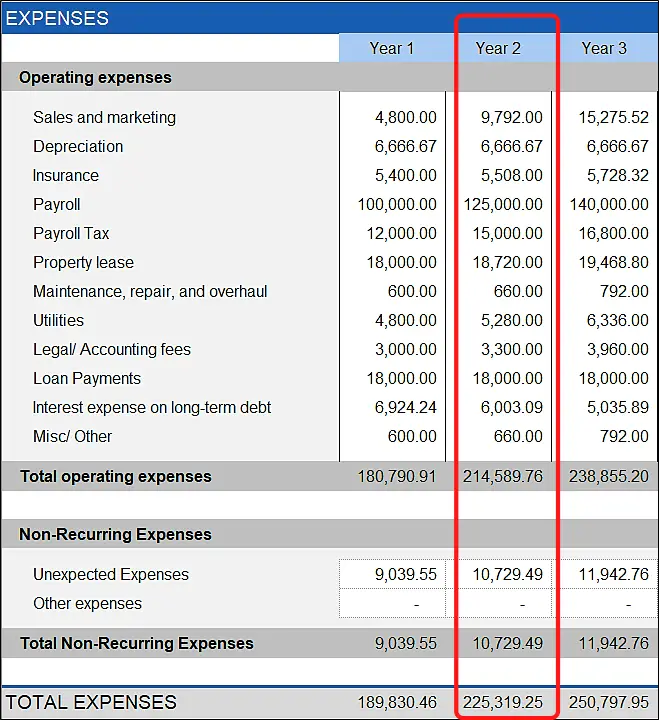
A few things stick out to me right away. With decreased demand comes decreased labor and payroll taxes. I am not suggesting cutting everyone.
- Make the work flow more efficient – detailed in the following section. The weekly labor could go down say 10% with a similar decline in payroll taxes.
This amounts to $240.40 per week in labor savings, and a $375 quarterly savings on payroll, likely more. - Back out of traditional ads and marketing. Depend on Word of Mouth Marketing-WOMM, including brand ambassadors, special limited edition products and utilizing Social Media to the maximum. Social media is my least favorite but plays a big role in the market today. See the article, 13 of the Proven Most Effective Beer Marketing Tactics, for more details.
Marketing expenses would decline by half. $94.15 per week. You may have to add Cost of Goods- COGS back into account for promotional product cost. - Bring your accounting in-house. My figures here are already low. With the software available now (see below in section: A Business Modeling System), there will be little need to pay someone else for basic bookkeeping. Also, there are a number of legal filings or transactions that may be done solo. These fees could be cut by 30% annually, perhaps more. $82.50 per month saved.
- As mentioned in another section, revisit your banker, wrap up debt in a bundle and get a better rate. They get nothing in default, so the bank has every motivation to work with you.
It’s possible, agreed improbable, they will suspend principal payments for a set period of time.
$346.15 of principal payment savings per week. In the very least, they may suspend interest payments for a set period of time, $115.44 per week. - Utilities and miscellaneous expenses. No need to itemize here, but I know from experience, this will save $200+ dollars per week.
- Energy usage. Many of you have a brewery fired by gas, oil, or both. I had an old steam boiler that ran on oil or natural gas. For a period of time, I think it was 2004, there was a rush on gas, following some major FUBAR in Iraq. The price of natural gas went up 40%. I switched out to the oil burner, knew a guy that salvaged cooking oil, and fired the brewery for a year and 8 months on old kitchen grease. I paid less than $1 a gallon and was green. I saved at least $150 a week. My oil harvester was fly-by-night so when winter came the oil solidified, and I returned to gas. However, the price gouging had eased.
In isolation, no single solution will grant immediate fiscal relief. Implemented in concert, it could mean $500 – 1000 a week in savings. This adds up quickly.
Operations and Work Flow: Balance and Improvement
Many breweries, most breweries are smaller affairs in the 500 – 3000bbl. annual range. Depending on configuration, retail – wholesale – both, they can be quite profitable at these modest sizes.
Production-wise, work is often performed by 2-5 skilled brewers and cellarmen. There is also the reality that inefficiency persists in key aspects of production. There is a concept in Operations Management called Balancing the Line.
This means that each step of production must balance out so that they have an equal time usage value.
For example: on brew day wort production looks something like this, estimates only:
| Task | Timing | Tasks to fill the down time |
| Mash-In | 20 min | Well, under the 50 min, check recipe, organize tools, recalculate hops, FOCUS on the day |
| Mash | 90 min | Scrub and caustic the fermenter. |
| Vorlauf | 40 min | Needs to be watched, under the 50min |
| Sparge | 75 min | Watch it yes, can multi-task |
| Kettle heating | 30 min | Dead time, sanitize the fermenter |
| Boil | 90 min | Yes, hop additions, but at least 30 min of dead time, yeast prepping, organize |
| Whirlpool | 15 m.in | Well-under the 50m. Scoop the lauter |
| Knock-Out/ Cooling | 40 min | Under the 50 min, start cleaning the lauter-tun |
| Average | 50 min |
To properly balance the line and maximize work efficiency, each step needs to take 50 minutes.
Well, it doesn’t. If the brewer is standing around during the boil, for example, watching the cellar guys, baby-sitting the kettle, drinking beer, talking smack, ALL of which I did in the brewhouse, and sometimes OK. However, the work efficiency is quite poor. That 40 wasted minutes (90m/ boil minus the 50m. average) must be made up.
You needn’t treat guys like indentured servants, and they need to stay busy, period, especially as many may be hourly. If you have an hourly shift brewer, it could take him 9-12 hours on a brew day. Yet it could take him 7-8. Multiply this saved time by brews per year, that is your weekly savings, plus payroll taxes.
See the notes in the 3rd column above about how to lean towards balancing this time.
Example : Kegging
Here is an element of semi-skilled labor where precious time is lost.
I’ve scrubbed kegs and packaged all-night long. If I was alone, I could take my time. That said, I never relished the task so worked hard to make it faster.
Kegs – Balance the packaging line – availability, cleaning, and filling
- Balancing the line – sounds crazy but it takes 9.5 m. to take a dirty keg and fill it, done by twos, this is 12.6 kegs per hour (60m/ 9.5m x 2) =12.6
- Your process times expressed in minutes are: 2 + 4.5 + 2.5 + .5 = 9.5m.
- Your goal is to make these four steps equal. 2.38 m. x 4 = 9.5
- By balancing this process, you leave time for simultaneous filling and palletizing.
|
Recover:
dump old beer |
*currently crew is scrubbing and filing separately: they can, and should be done together | *we assume a two head- semi-automated cleaner and manual filler | |
|
Outside – 2m. (x2)
2.38m. |
Inside – 4.5m. (x2)
2.38m. |
Fill – 2.5m. (x2)
2.38m. |
Palletize– .5 m.
2.38m. |
- The most kegs you can clean in an hour is 26.67 = 60m./ 4.75m.= (12.63 x 2)
- This is the most that should also be scrubbed, filled, and palletized based on your largest constraint, the inside wash. Your constraint is your bottleneck.
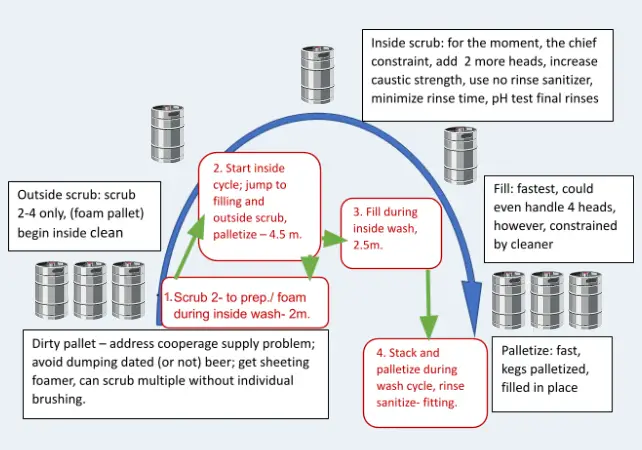
- Filling occurs at a rate of about 24 units per hour.
Result – balanced line (within reason) add .5 m for overlap. I’ve seen the keg scrubbers go at it. and I’ve seen them stand around and watch the keg machine cycle, wasting precious time. How do you motivate them to do better is your puzzle.
My point is you can clean the outside, inside, and fill by recovering that inside wash time by simultaneously filling. You increase your speed and efficiency by 40%+. Your labor was just cut by 40%, 2 hours of cleaning and filling now become 1 hour, 12 minutes.
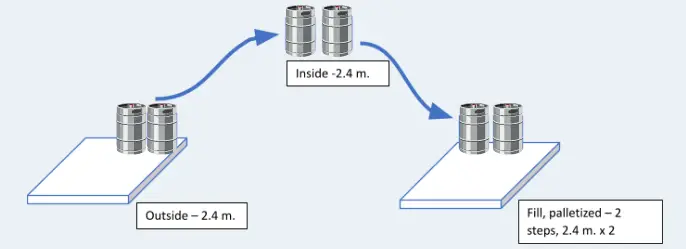
| Unbalanced | Total | ||||
| Wash 1 hour | Fill 1 hour | Average | Time | Labor Cost | Annual Barrelage packaging Cost |
| 26.6 | 24 | 25.3 | 2 hours | $25./ $12.50 an hour | 2,000 bbls.
237 hours $5,925 |
| Balanced | |||||
| 26.6 | 24 | 25.3 | 1.2 hours | $15. | 2,000 bbls.
237 hours $3,555. |
| Annual savings | $2,370 | ||||
| *This savings represents savings on ½ kegs alone and is a sample model.
It may be applied to EVERY aspect of production. |
|||||
A business modeling system
Many run their businesses like they run their house, loosely and personally. Let’s start a new way. Expenses must be accounted for down to the penny.
I worked with this group personally, helping them model their brewery modeling software components. The software is called Decision Critical.
Here is a brief sample of their product features.
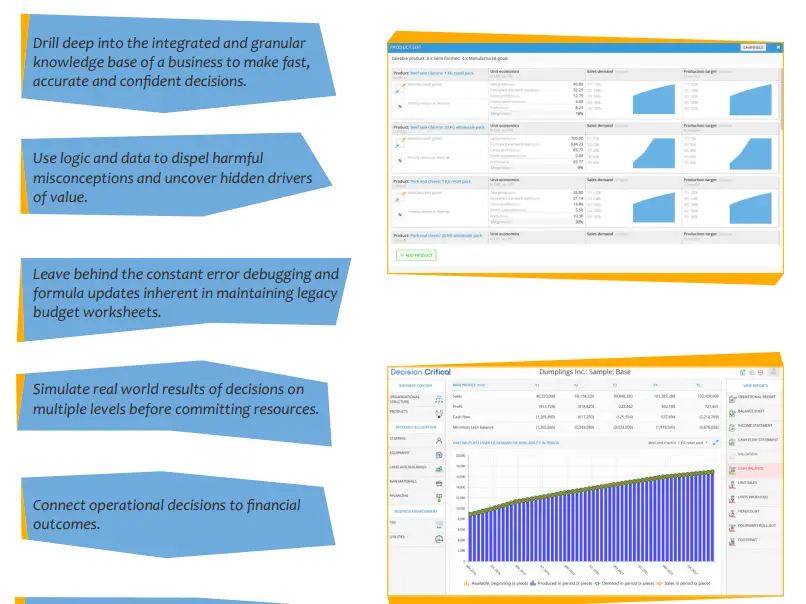
The cost of producing beer must be accounted for down to the penny. As production increases, COGS (cost of goods sold – ingredients) increases in tandem, albeit with possible bulk discounts.
Some services such as rent are fixed and will be lower in cost. Here is just a tiny snapshot of what modeling software can do for you.
This is a brief snapshot of COGS for a single product.
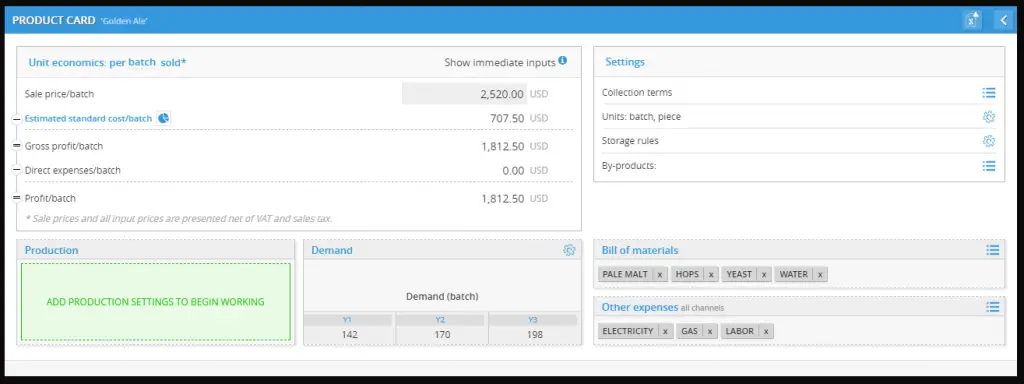
This image shows a seasonal growth curve over 3 years. Yes, Jan-Feb are LEAN. This may be a subjective example!
Decision Critical offers advanced analytical modeling to help track every last aspect of your business down to the penny. It may not be exciting, yet it is absolutely essential. I would make no move without it.
Use the buyer’s code Jonas@KMB, if you decide to integrate Decision Critical into your business.
Analyze and consider all costs, to the cent
Utilities, payroll and maintenance will increase gradually and in a gentler curve than production.
Either way, you need to see this with your very eyes, and know exactly where the savings are on a given day, week or season. It brings increased participation by the in-house partners, not just number crunchers.
I’ve been introduced to a business modeling software that makes day-to-day decision-making not only easier but logical and measured.
With its clear analytics, at a glance you can see what the $.02 per pound increase in malt will do, or what switching from German to American Tettnanger hops will do.
More importantly, what is the interest expense savings on a refinance, the labor savings on a balanced line, or a switch to more efficient energy.
Good modeling will give these answers almost instantly. I’ve walked a mile in your moccasins. It is not an easy road. If I’d had this software, I would have made different choices.
When I build a business plan for a brewery, I use Decision Critical to build it from the ground up. It allows you to see all aspects of operations, and how they are interconnected.
Decision Critical is modestly priced subscription-based software and the money it saves is worth its weight in raw barley or full kegs. Use the buyers code Jonas@KMB, if you decide to integrate Decision Critical into your business.
Bridge Loans
The last and least desirable must be mentioned.
Sometimes there needs to be cash today and that is it, the long and the short of it. A vendor must be paid or taxes are due, and no amount of phone calls will alter these facts.
Many breweries are small Sub-S corporations or LLCs (Limited Liability Corporations). Therefore they are held by a very small private group of investors; friends, family, and community members.
Following your instincts and making sound choices
There is no silver bullet.
If there are deep pockets at your disposal, go to the well again. If you took a calculated risk and bet on yourself, that is OK too. You made a good decision, now stick with it.
Look at everything under a microscope. Look at the organization from an outsider’s perspective. There is money sitting on the floor, in the tanks, and in the labor of your crew. Take it to heart, use your mind and find the value.
Reach Out to Us
KMB Consulting can assist you in all of your challenges, large or small. Brewers need support and input. It is an artisanal craft, refined by years in the brewhouse. It is also an uncommonly specialized business.
Today’s brewers have puzzles that need a fresh perspective. I’ve walked in your shoes. I know the victories and struggles that come with the brewer’s life.
Reach out to us. No problem is unfixable.


